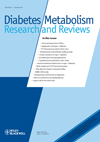Self-monitoring of blood glucose (SMBG) improves glycaemic control in oral hypoglycaemic agent (OHA)-treated type 2 diabetes (SMBG-OHA study)
Abstract
Background
We conducted a clinical research study to determine the effect of self-monitoring of blood glucose (SMBG) on glycaemic control and the value of a putatively less painful blood sampling technique on SMBG in oral hypoglycaemic agent-treated type 2 diabetes patients; SMBG has not been broadly applied in non-insulin-treated patients in Japan.
Methods
One hundred thirty-seven subjects were recruited for the 24-week, prospective, comparison study and randomized into three groups: 46, no SMBG group; 46, fingertip group; and 45, palm group. The primary endpoint was change in HbA1c. The secondary endpoints were SMBG compliance, dropout rate, treatment changes, and patient's and physician's satisfaction.
Results
Six subjects in the fingertip group (13.2%) and one subject in the palm group (2.2%) were dropped because of pain. A1C level of all subjects at 24-week was decreased more in the fingertip (−0.23%) and palm (−0.16%) groups than that in the no SMBG group (+0.31%) (p < 0.05). SMBG compliance was higher in the fingertip group (2.17 times/day) than that in the palm group (1.65 times/day) (p < 0.05). A1C level of treatment-unchanged subjects was decreased more in the fingertip (−0.25%) and palm (−0.21%) groups than that in the no SMBG group (+0.30%) (p < 0.05). SMBG compliance was higher in the fingertip group (2.24 times/day) than that in the palm group (1.65 times/day) (p < 0.05). Patient's questionnaire showed that 84.1% of the fingertip group and 90.2% of the palm group were satisfied with SMBG. Physician's satisfaction was higher in the palm group (94.0%) than that in the fingertip group (80.0%) (p < 0.05).
Conclusion
SMBG is beneficial for glycaemic control, and palm blood sampling is a useful procedure for oral hypoglycaemic agent-treated type 2 diabetes. Copyright © 2012 John Wiley & Sons, Ltd.




